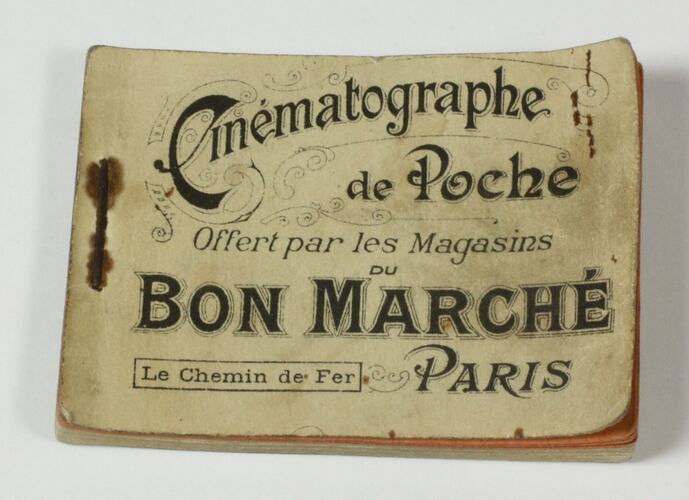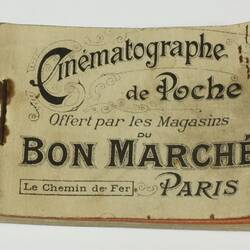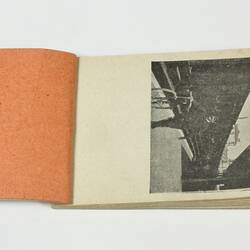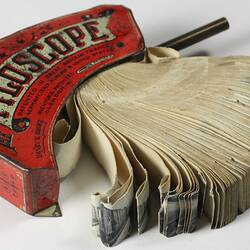Summary
Flick book, produced in France for the department store Bon Marche, showing a photographic sequence of a man with a bicycle walking past a stationary train. If the viewer flicks the pages backwards the sequence is reversed, with the train pulling past the man. The flick book is made up of a number of pages, each having a related but slightly different static image drawn on them, which together record a sequence of movement. To create the animation the flick book is held in one hand, the thumb of the other hand flicks the pages in sequence, allowing the viewer to see each page in rapid succession.
While there is no exact date for the invention of the flick book, the first known patent was filed in Britain on 18th March 1868. John Barnes Linnett, a printer in Birmingham, put forward 'The Kineograph a new optical illusion'.
The flick book was part of a range of popular philosophical or optical toys created in the 19th century. Like the flick book, most attempted to create the illusion of movement using a series of static images.The flick book had its height of popularity at the end of the 19th and beginning of the 20th centuries, it is however still produced to this day. It has been known under a variety of names; flick, or flicker book in Britain, flip book in the US, Daumenkino (thumb cinema) in Germany and Kineograph, Cinema de poche (pocket cinema) in France. Many other less common names were also used.
This flick book is part of the Francis Collection of pre-cinematic apparatus and ephemera, acquired by the Australian and Victorian Governments in 1975. David Francis was the curator of the National Film and Sound Archive of the British Film Institute as well as being a co-founder of the Museum of the Moving Image in London, which was operational between 1988 and 1999.
Physical Description
Flick book of 30 pages made of heavy paper. The first four pages are orange and feature advertising, the next pages show the animation sequence. Printing is in black. Single metal staple along bottom margin.
More Information
-
Collection Names
-
Collecting Areas
-
Acquisition Information
Loan & Subsequent Donation from Australian Film Institute (AFI), Mr David Francis, by Nov 1990
-
Collector
Mr David Francis, London, Middlesex, England, Great Britain, 1990
-
Patentee
Mr John B. Linnett, Birmingham, England, Great Britain, 1868
Of flickbook -
Place & Date Manufactured
-
Inscriptions
Cover page: 'Cinematographe/de Poche/Offert par les Magasins/DU/BON MARCHE/Le Chemin de Fer/PARIS'
-
Classification
-
Category
-
Discipline
-
Type of item
-
Overall Dimensions - Closed
67 mm (Width), 13 mm (Depth), 49 mm (Height)
-
References
[Link 1] Accessed 11 May 2010
-
Keywords
Advertising, Optical Illusion Devices, Optical Toys, Pre-Cinema Moving Images



